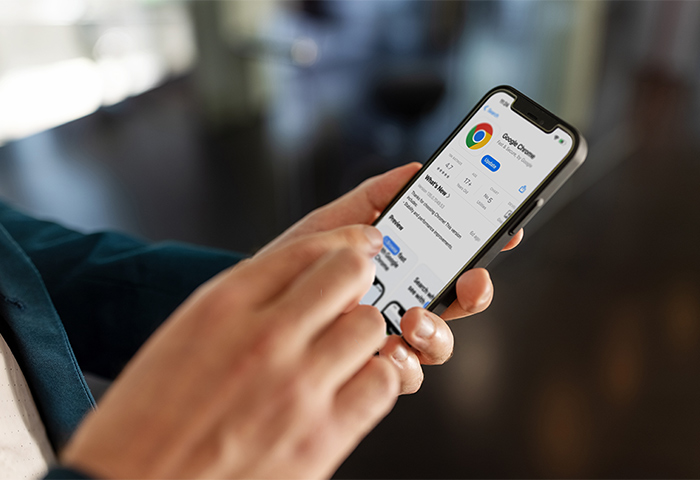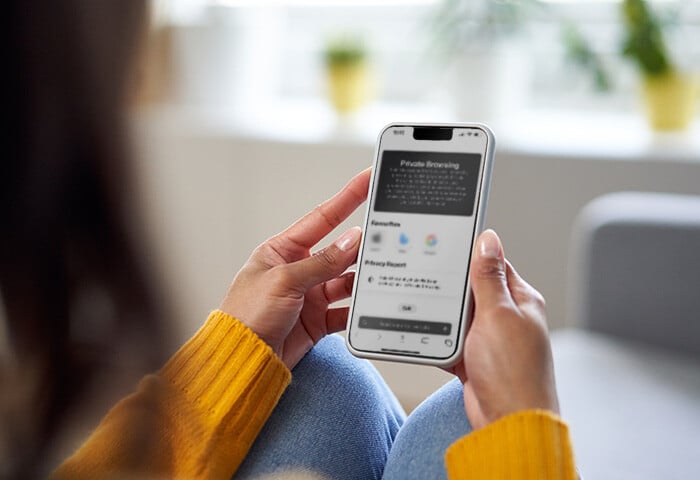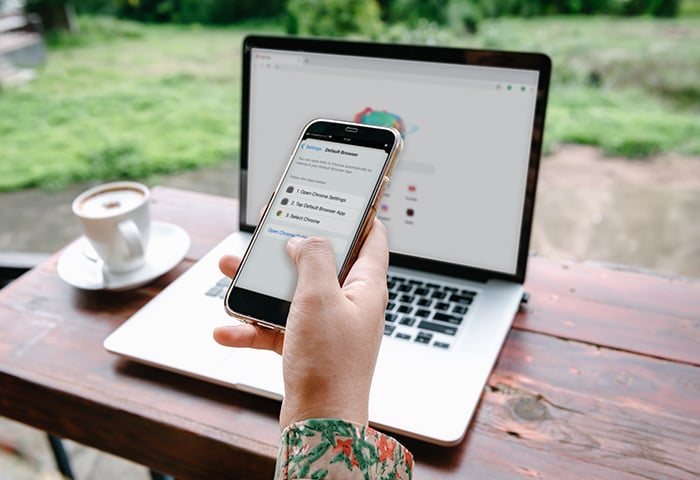How to turn on Private Browsing on an iPhone or iPad
Turning on Safari Private Browsing on your iOS device is a simple matter of opening a Private Browsing tab in the Safari app. While in Private Browsing mode, Safari won’t store your search history or autosave your personal information such as passwords or credit card numbers.
Here’s how to turn on Private Browsing on an iPhone and iPad:
-
Open Safari on your device and tap the Tabs icon at the bottom-right corner.

-
Swipe to Private at the bottom of the screen and select Private to open a Private Browsing tab.

Remember that enabling Private Browsing won’t apply it to the tabs you already have open. You can only browse privately on tabs you open with Private Browsing. This is similar to Google Chrome’s incognito mode for iPhone.
Also, bear in mind that Private Browsing doesn’t automatically prevent pop-ups, but there are other ways to allow or disable pop-ups for smoother browsing.
How to exit private mode in the Safari App
If you no longer need to keep your browsing history private, simply turn off Private Browsing in Safari by closing the private tab you’re using. This will enable cookies and temporary files, making it easier to access your favorite websites and fill in forms automatically. You can always go back and delete your cache and browsing history later.
Here’s how to turn off Safari Private Browsing on iPhone and iPad:
-
Tap the Tabs icon at the bottom-right corner of Safari and swipe left on a private tab or tap the X in the top-right corner to close it.

-
At the bottom of the screen, swipe to X Tabs (X being the number of open tabs) to resume non-private browsing. If no tabs are currently open, swipe to Start Page at the bottom of the screen to open a new tab.

How to open a private browser on a Mac
To launch a Safari private window on your desktop or MacBook, all you have to do is press Command + Shift + N on your keyboard. Or you can open and manage Private Browsing within the Safari app itself.
To turn on Private Browsing mode within the Safari browser app:
-
Open Safari from your Dock or Launchpad.

-
Click File in the top-left corner of your screen and select New Private Window from the dropdown menu.

How to set private mode as your default browsing option
If you want to surf Safari incognito every time you browse, you can make private tabs on Safari your default option. By doing this, you can prevent Safari from ever storing your cookies or history locally. This is only recommended if you are using a public computer or if others use your Mac regularly.
To make Private Browsing your default browsing setting, visit your Safari privacy settings and follow these steps.
-
Open Safari in your Dock or Launchpad.

-
Select the Safari menu in the top-left of the screen and click Preferences (or click Command + ",").

-
Click the General tab, find Safari opens with, and click the dropdown menu. Select A new private window from the dropdown.

In some cases, Safari may open automatically, like when you click a link. To browse incognito in Safari when clicking a link, right-click on the link and select Open link in new private window. This only works if Safari is your default browser.
How to exit private mode on Mac
To go back to normal browsing on your Mac, you need to exit Safari incognito mode. If you’re concerned about managing your browsing history, you can still manually clear your browsing and search history when browsing with non-private tabs.
Follow these steps to turn off private browsing in Safari:
-
Close the Private Browsing window by clicking the X in the top-left corner.

-
Click the Safari icon in your Dock or Launchpad to open a new non-private Safari window.

If you’ve set Private Browsing as your default option, you need to update your settings in the Safari Preferences menu before following the steps above.
What is incognito mode on iPhone, iPad & Mac?
Incognito mode on Apple devices, such as Macs and iPhones, is known as “Private Browsing” or “private mode.” Most devices and browsers have private browsing functions. Google’s name for it is “incognito mode,” and Apple’s is “private browsing.” Both do the same thing, which is prevent your browsing activity data from being stored on your device.
If you have an Apple device, your default browser is Safari. But you can browse incognito with a different browser if you’d like, such as Google Chrome, Edge, or AVG Secure Browser. Chrome and Edge offer the same private browsing benefits as Safari. AVG Secure Browser offers advanced safety features such as malware protection, ad blocking, and customizable privacy settings.
Like Google Chrome’s incognito mode, Private Browsing mode on Safari removes temporary files, including cookies and form data. It also clears your search history automatically. It’s a bit like covering your tracks as you search, but it only hides your activity from others who use your physical device. iPhone private browsing does not hide your IP address or let you browse safely protected from online threats.
What’s the difference between private and normal Safari?
The difference between private and normal Safari relates to what your device remembers about your browsing activity. In normal mode, Safari saves cookies to help load websites faster, remember personal information, and save your accounts’ login credentials. It also records your search history so you can view all the sites you’ve visited recently.
When you enable Private Browsing on Safari, none of that data is saved on your device. If someone were to find your phone and open Safari, they would find no trace of your online activity. Private mode also limits iCloud sync between Apple devices, search suggestions, and website tracking, offering a more secure browsing experience.
Is Safari private mode really private?
Private browsing only protects your privacy from others accessing your physical device. It does nothing to hide your browsing data from advertisers, hackers, and other third parties like your ISP. Incognito mode in Safari still lets websites and other third parties track your online activity, and unless you’re using a private search engine, your searches will still be logged.
Unlike a VPN, Safari Private Browsing doesn’t block your IP address or allow you to surf the web anonymously. To keep your web activity safer from local and online privacy threats, use AVG Secure VPN to encrypt your connection and help protect the data you send and receive online.
Troubleshooting issues with Safari’s private mode
There are some well-known quirks to how Safari private mode works, so if you encounter any issues, rest assured you’re not the only one. Here’s a look at the most common problems that users have with Private Browsing and how to resolve them.
Private Browsing option is gone or grayed out
If you can’t turn on Private Browsing, it’s likely because you have Screen Time restrictions active on your device. Here’s how to turn them off:
On iPhone and iPad
-
On your home screen, click the Settings icon and select Screen Time from the menu. In the Screen Time menu, click Content & Privacy Restrictions.

-
Select Content Restrictions followed by Web Content. Then tap Unrestricted on the Web Content menu.

On Mac
-
Click the Apple menu at the top-left corner of your screen and select System Preferences.

-
Click the Screen Time icon.

-
On the sidebar, click Content & Privacy.

-
Next to Web Content, select Unrestricted Access.

Private Browsing on Safari is slow
If you’re having performance issues with Private Browsing, you may need to close your non-private Safari tabs. Your device uses memory and processing power to maintain your private browsing separately from your normal browsing. So, you’re putting a lot of strain on your device when you have private and non-private tabs open at the same time.
Elevate your privacy with AVG Secure Browser
Enabling Private Browsing in Safari is an effective way to hide your online activity from other people who may use your device. But for a safer browsing experience, download a dedicated private browser. AVG Secure Browser provides built-in safety features like ad blocking and anti-malware protection. Plus you can customize your privacy settings according to your needs.
































